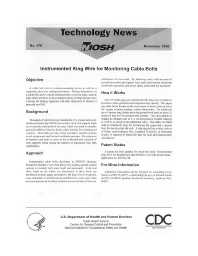Mining Publication: Technology News 476 - Instrumented King Wire for Monitoring Cable Bolts
Original creation date: November 1998
A cable bolt can be a strain-measuring device as well as a supporting device in underground mines. Placing instruments on a cable bolt allows certain characteristics of a rock mass, such as high strain and load, to be evaluated during mining and provides a means for mining engineers and mine inspectors to forecast a potential roof fall. Thousands of cable bolts are installed in U.S. mines each year. Studies performed by NIOSH researches show that support loads can exceed the yield point of the steel, which can result in unstable ground conditions that pose direct safety hazards for underground workers. Rock falls can also create secondary hazards, such as carved escape ways and blocked ventilation passages. Development of methods and tools to assist in the evaluation and selection of rock supports could reduce the number of unplanned rock falls significantly.
Authors: LA Martin, RP Curtin
Technology News - November 1998
NIOSHTIC2 Number: 20000645
U.S. Department of Health and Human Services, Public Health Service, Centers for Disease Control and Prevention, National Institute for Occupational Safety and Health, Technology News 476, 1998 Nov :1-2
See Also
- Bolt Load Changes During Initial Face Advance and Cross-Cut Breakthrough
- A Case Study of Bolt Performance in a Two-entry Gate Road
- Determination of Physical Properties of Cable Bolts in Cement Grout Pull Tests Using Instrumented King Wires
- Evaluation of Instrumented Cable Bolts in Cement Grout to Determine Physical and Numerical Modeling Properties
- Make it Safer with Roof Screen
- Optimizing Secondary Roof Support with the NIOSH Support Technology Optimization Program (STOP)
- Overview of Coal Mine Ground Control Issues in the Illinois Basin
- Roof Screening: Best Practices and Roof Bolting Machines
- Technology News 483 - Safety Training Tools for Rock Scaling Personnel
- Updating the NIOSH Support Technology Optimization Program (STOP) With New Support Technologies and Additional Design Features
- Content source: National Institute for Occupational Safety and Health, Mining Program


 ShareCompartir
ShareCompartir
